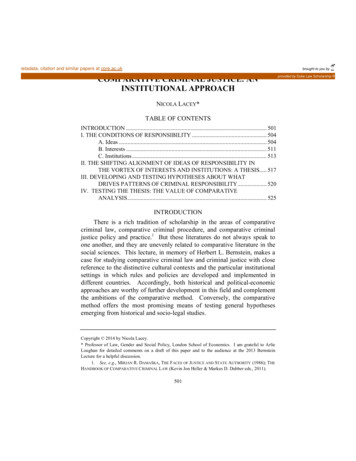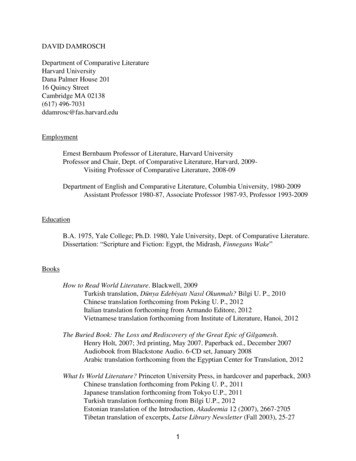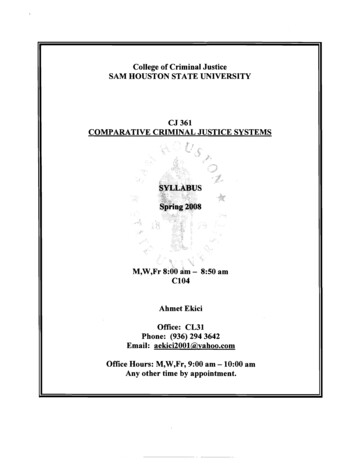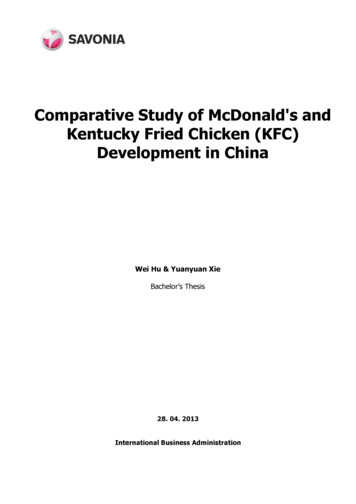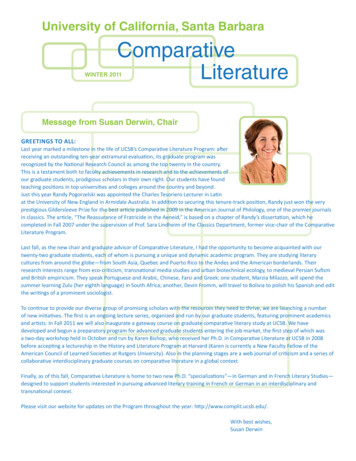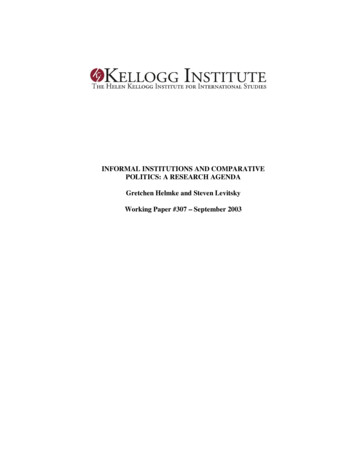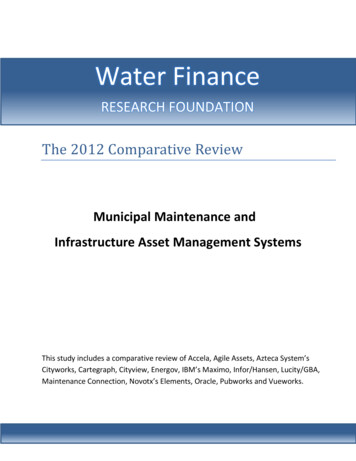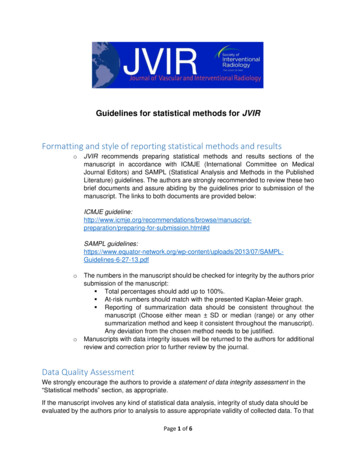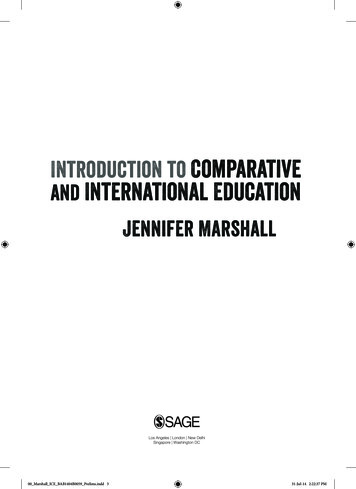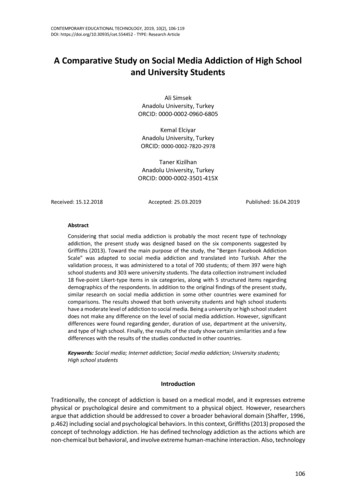
Transcription
CONTEMPORARY EDUCATIONAL TECHNOLOGY, 2019, 10(2), 106-119DOI: https://doi.org/10.30935/cet.554452 - TYPE: Research ArticleA Comparative Study on Social Media Addiction of High Schooland University StudentsAli SimsekAnadolu University, TurkeyORCID: 0000-0002-0960-6805Kemal ElciyarAnadolu University, TurkeyORCID: 0000-0002-7820-2978Taner KizilhanAnadolu University, TurkeyORCID: 0000-0002-3501-415XReceived: 15.12.2018Accepted: 25.03.2019Published: 16.04.2019AbstractConsidering that social media addiction is probably the most recent type of technologyaddiction, the present study was designed based on the six components suggested byGriffiths (2013). Toward the main purpose of the study, the "Bergen Facebook AddictionScale" was adapted to social media addiction and translated into Turkish. After thevalidation process, it was administered to a total of 700 students; of them 397 were highschool students and 303 were university students. The data collection instrument included18 five-point Likert-type items in six categories, along with 5 structured items regardingdemographics of the respondents. In addition to the original findings of the present study,similar research on social media addiction in some other countries were examined forcomparisons. The results showed that both university students and high school studentshave a moderate level of addiction to social media. Being a university or high school studentdoes not make any difference on the level of social media addiction. However, significantdifferences were found regarding gender, duration of use, department at the university,and type of high school. Finally, the results of the study show certain similarities and a fewdifferences with the results of the studies conducted in other countries.Keywords: Social media; Internet addiction; Social media addiction; University students;High school studentsIntroductionTraditionally, the concept of addiction is based on a medical model, and it expresses extremephysical or psychological desire and commitment to a physical object. However, researchersargue that addiction should be addressed to cover a broader behavioral domain (Shaffer, 1996,p.462) including social and psychological behaviors. In this context, Griffiths (2013) proposed theconcept of technology addiction. He has defined technology addiction as the actions which arenon-chemical but behavioral, and involve extreme human-machine interaction. Also, technology106
CONTEMPORARY EDUCATIONAL TECHNOLOGY, 2019, 10(2), 106-119DOI: https://doi.org/10.30935/cet.554452 - TYPE: Research Articleaddiction is portrayed as a passive behavior like watching TV, playing a video game, and chattingonline.Internet addiction is a special type of technology addiction. The term “Internet addiction” wasdefined for the first time by Ivan Goldberg in 1995 as a psychological illness (cited in Kim, 2009).Different conceptualizations were used for abusing Internet. Young (1998) named it as “internetaddiction”, Morahan-Martin and Schumacher (2000) used the term “pathological internet use”,Davis, Flett and Besser (2002) labelled it as “problematic internet use” (cited in Caplan, 2002,p.554).Young (1998) suggests five types of Internet addiction: (a) cyber sexual addiction, (b) cyberrelationship addiction to online friendships or affairs, (c) net compulsions to online gambling,auctions or obsessive trading, (d) information overload to compulsive web surfing or databasessearches, and (e) computer addiction to game playing or programming.When properly used, Internet is an important technology that provides people with vital skillsfor the 21st century such as information access, problem solving, and self-directed learning.However, when Internet is used unconsciously, it can cause anxiety or fear and negatively affectpersonal development (Colwell & Kato, 2003; Kerberg, 2005). In addition, excessive use ofInternet may have detrimental effects on biological, physiological, psychological and socialdevelopment of the user (Caplan, 2002). In this context, Internet addiction has gradually becomea serious problem. Thus, although it was not mentioned in the previous editions, AmericanPsychiatric Association (APA) has added Internet addiction, with a particular reference to onlinegambling, as a mental illness to the fifth edition of the Handbook of Diagnostic and StatisticalManual of Mental Disorders (American Psychiatric Association, 2013).In many areas of behavioral addiction, it has been debated that whether some extremebehaviors can really be regarded as addiction or not. Social media addiction, as a special type ofInternet addiction, has been discussed in this context. Griffiths (2013) made an importantcontribution to this discussion by suggesting six essential components to describe a behavior asaddiction. These six components are salience, tolerance, mood modification, relapse,withdrawal, and conflict (Griffiths, 2013, p.121). He states that a behavior can be defined asaddiction if it has these six components. Then, the critical question becomes what does each ofthese six components mean? To make the subject or issue more understandable, Griffiths (2013)explains these six components as follows: Salience: This occurs when social networking becomes the single most importantactivity in a person’s life and dominates his or her thinking, feelings, and behavior. Forinstance, even if people are not actually engaged in social networking, they will beconstantly thinking about the next time that they will be. Mood modification: This refers to the subjective experiences that people report as aconsequence of social networking and can be seen as a coping strategy (i.e., theyexperience an arousing “buzz” or a “high” or, paradoxically, a tranquilizing feeling of“escape” or “numbing”). Tolerance: This is the process whereby increasing amounts of social networking activityare required to achieve the former mood-modifying effects. This basically means thatfor people engaged in social networking, they gradually build up the amount of thetime they spend social networking every day.107
CONTEMPORARY EDUCATIONAL TECHNOLOGY, 2019, 10(2), 106-119DOI: https://doi.org/10.30935/cet.554452 - TYPE: Research Article Withdrawal symptoms: These are the unpleasant feeling states and/or physical effects(e.g., the shakes, moodiness, irritability) that occur when people are unable to engagein social networking because they are ill, on vacation, prohibited etc. Conflict: This refers to the conflicts between a person and those around that person(interpersonal), conflicts with other activities (social life, hobbies, and interests), orfrom within the individual himself or herself (intrapsychic conflict and/or subjectivefeelings of loss of control) that are concerned with spending too much time on socialnetworking. Relapse: This is the tendency or desire for repeated reversions to earlier patterns ofexcessive social networking to recur and for even the most extreme patterns typical ofthe height of excessive social networking to be quickly restored after periods ofpersonal control.Around the world, a number of studies have been conducted on whether the Internet and itsapplications are addictive or not. For example, in a study conducted in China which was attendedby 2,620 students, it was identified that 24% of the participants were addicted to social media.One of the notable points here is that students who have developed high scores on addictionhave got low scores on time management. In addition, internet-addicted adolescents providedmeaningful results in emotional symptoms, problem management, hyperactivity situations andlower social behavior scores (Cao et al, 2007).Social network sites are virtual communities where users can create individual or public profiles,interact with friends in real life, and come together with other people based on commoninterests (Kuss & Griffiths, 2011, p.3529). When considering the history of social networkingsites, the first social networking example – Six Degrees - was published in 1997 on a basis thatwould allow everyone to connect via six-degree distance. In 2004, Facebook was established,which is now considered as the most successful social networking site. The site has expandedvery quickly and has become a global network with more than 2.3 billion users as of January2019 (wearesocial.org), with more than half of the users logging every day. Social networks arepredominantly used for social purposes and for the continuation as well as the development ofindividuals’ offline connections (Kuss & Griffiths, 2011, p.3528).Nowadays, intensive use of social media applications by ordinary users has increased; and thishas raised the concerns for addiction. Surveys consistently show that young people and studentsbenefit most from social networks in the general population (Kuss & Griffiths, 2011). The rapidincrease in the use of online networks -mainly on the basis of time spent- has led someresearchers to argue that excessive social networking can lead to addiction in individuals(Griffiths & Pontes, 2014, p.120; Sussman et al., 2011). From time to time, individuals can havea variety of actions that are potentially addictive, such as using social networks extensively.These behaviors do not always have to be addictive, sometimes they are just behaviors whichlead to addiction.Studies on social media addiction levels have produced inconclusive results because some areconcerned about negative consequences of intensive use, while others have focused on gainsthrough the use of social media. However, the latest research showed that greater access tosocial media brings greater concerns. For many institutions, social media addiction has becomea major concern since the beginning years of social networks. For example, Davies and Cranston(2008) found that participants (120 managers and practitioners working on youth) were afraidthat online social networking would replace other activities and face-to-face social interaction108
CONTEMPORARY EDUCATIONAL TECHNOLOGY, 2019, 10(2), 106-119DOI: https://doi.org/10.30935/cet.554452 - TYPE: Research Articleamong people. When participants were asked to identify the risks associated with online socialnetworks, 23% reported addiction as a source of concern and the others reported exposure tobullying (53%), disclosure of personal information (35%), and sexual assault (22%).Koc and Gulyagci (2013) found that Facebook addiction was related to factors such as usagetime, social motivations, depression, anxiety, and insomnia. However, they did not find anysignificant relationships regarding demographic factors. In several studies, researchers foundthat frequent access to Facebook is associated with clinical manifestations of psychiatricdisorders (Rosen et al., 2013), the excessive use of social media can disrupt interpersonalrelationships by jeopardizing the quality of relationships people develop with others (Tokunaga,2011), and it might reduce self-esteem (Peter & Valkenburg, 2006).There are a number of social and psychological factors that affect social media addiction. Therole of parents is particularly emphasized by researchers. It has been reported that while thelack of family love (Huang & Leung, 2009) and the conflict between parents and children (Yen,Ko, & Yen, 2007) may lead to dependent behaviors; supportive parental supervision (Lin, Ko, &Wu, 2009) decreases the impact on dependent behaviors. Many other variables, such as theneed to establish a close relationship, narcissistic behavior, excess of leisure time, and thelimitations of the social environment may be determinants of social media addiction. At thesame time, negative effects on adolescents, who are practically students, can sometimes bereflected in academic performance and social capital.In short, social media addiction is an ever-increasing problem in the 21st century. For this reason,a number of studies were conducted in various countries on this subject. Each study presents anew outcome, explains reasons and effects of the social media addiction, and presents new waysof solutions. However, the problem is getting bigger and becoming more prevalent every dayand public authorities, educators, and parents know neither the scope nor the extent of thischallenge. Turkey is no exception as a country that ranks among the top countries in the worldwhen it comes to the use of social media. Considering that the possible actions against addictiveuses of social networking sites depend largely on understanding the seriousness of the problem,this study may shed some light on the current situation among particularly young users inTurkey. This rationale sets the need for the current study.Within this framework, the main purpose of the present study is to identify the social mediaaddiction level of high school and university students based on internationally-recognizedmeasures and compare it with the situation in other countries where similar instrumentationwas used. Toward this main purpose, the following research questions were investigated: What is the social media addiction levels of high school and university students based oninternationally-recognized measures? Are there significant differences between social media addiction levels of high school anduniversity students in general and in terms of sub-categories of technology addiction? Are there significant differences in social media addiction levels of students in terms ofgender, school type, department, and duration of daily use? Is social media addiction level of Turkish students different from the social mediaaddiction levels of students in other countries?109
CONTEMPORARY EDUCATIONAL TECHNOLOGY, 2019, 10(2), 106-119DOI: https://doi.org/10.30935/cet.554452 - TYPE: Research ArticleMethodsParticipantsThe literature suggests that majority of social media users are teenagers and young adults. Inpractical terms, high school students are teenagers and university students are young adults.Considering that most of the social media users fall within these two categories, their age groupsmake them potentially more vulnerable for social media addiction compared to other segmentsof the population. For this reason, the sample of the present study was chosen from among highschool and university students. Table 1 shows the composition of the sample.Table 1. Characteristics of the ParticipantsFemaleMaleTotalHigh SchoolAnatolian High SchoolScience High t of Communication DesignDepartment of JournalismDepartment of Cinema-TVDepartment of Public 3174700The sample of the study consisted of 700 students. Of them, 345 (49%) were female and 355(51%) were male. Gender distribution was almost equal. As far as their schools are concerned,397 (57%) of the participants were high school students and 303 (43%) participants wereuniversity students. High schools students formed the majority with a difference of 14%.Regarding the amount of time they spend on social media per day, 115 (16%) students usedsocial media for less than an hour, 344 (49%) used for 2-3 hours, 145 (21%) used for 4-5 hours,and 96 (14%) used for more than 5 hours. It appears that approximately 85% of students usesocial media for more than 2 hours per day. The students in the sample also had a high level ofmobile phone ownership (96%).The composition of the high school sub-sample is generally similar to that of the total sample,partly due to the fact that it formed the majority. Within the high school sub-sample, 52% werefemale and 48% were male; 48% were in Anatolian High School and 52% were in Science HighSchool; 84% use social media for more than 2 hours a day; and 96% have their own mobilephone.The composition of the university sub-sample is a little bit different. Within this group, 46% werefemale and 54% were male; 55% were in the Department of Communication Design andManagement, 11% were in the Department of Journalism, 10% were in the Department ofCinema and Television, 24% were in the Department of Public Relations and Advertising; 87%use social media for more than 2 hours a day; and 99% owned a mobile phone.110
CONTEMPORARY EDUCATIONAL TECHNOLOGY, 2019, 10(2), 106-119DOI: https://doi.org/10.30935/cet.554452 - TYPE: Research ArticleGeneral demographics of the total sample as well as the sub-samples are in compliance with theselection criteria employed in the study; that is, the researchers have assumed that both thestudents in the private high school system and the university students in the Faculty ofCommunication Sciences have a high level of mobile phone ownership, daily use, and exposureto social media applications.InstrumentationA Likert-type scale was used to collect data in this study. The scale consisted of two main parts.In the first part, participants' personal information regarding their gender, school, department,duration of daily use, and ownership of mobile phone were asked through structured items. Inthe second part, “Bergen Facebook Addiction Scale” (BFAS), which was developed byAndreassen, Torsheim, Brunborg, and Pallesen (2014), was used to collect data about socialmedia addiction of the participants. The fact that BFAS and parallel instruments were used inmany international studies has allowed researchers to compare the results of the present studywith the results of similar studies in other countries.The validation process of the scale has taken place in several phases. First, all the 18 items inBFAS were translated into Turkish. Also, because the original scale was about Facebookaddiction, the items were adapted to social media addiction. Secondly, language experts andsocial media specialists reviewed the translated version of the scale. Third, following severalminor revisions, the draft was pilot-tested with 25 high school and 25 university students. A fewrevisions regarding the wording of the items were made. Finally, after the pilot-test, obtaineddata were analyzed and Cronbach Alpha reliability coefficient of the scale was calculated as .89(it was found to be .90 in the actual study) so that the adapted scale was highly reliable.Participants' mean scores were used to determine both how intensely each of the symptoms ofaddiction is experienced by individuals, and the level of social media addiction they experience.Having a total of 18 five-point items and the possible response for each item ranging from 1 to5, the minimum possible score for the whole scale was 18 whereas the maximum possible scorewas 90. For the purpose of the study, the mean scores up to 20 (1.00-1.15 over 5 points) wereused to describe a natural use, 21-39 (1.16- 2.21 over 5 points) mild addiction, 40-69 (2.22-3.87over 5 points) moderate addiction, and 70-90 (3.88-5.00 over 5 points) severe addiction. Thesewere also the levels of addiction suggested in the original scale.BFAS has been used to collect data in a number of countries and each study set the cut-off valuesfor different levels of addiction. De Cook et al. (2014) in Belgium used the mean score of 2.00,Wang et al. (2015) in China used 3.00, and Jaffri (2015) in Bhutan used 4.00 as the critical scoredifferentiating non-addicted and addicted users. On the other hand, Salem et al. (2016) in Egyptused the following score ranges to differentiate addiction levels: 0-20 (natural use), 20-39 (mildaddiction), 40-69 (moderate addiction), and 70-90 (severe addiction).The present study assumed that these four layers may serve as better indicators of social mediaaddiction levels compared to a rigid dichotomous split as non-addicted and addicted. It wasassumed that it is more reasonable to measuring the levels of addiction rather than simplylabelling people as addicted versus non-addicted because sometimes there may be crucialdifferences among those categorized as addicted.111
CONTEMPORARY EDUCATIONAL TECHNOLOGY, 2019, 10(2), 106-119DOI: https://doi.org/10.30935/cet.554452 - TYPE: Research ArticleProceduresData collection procedures were generally similar for both sub-samples. After obtainingnecessary permissions from the selected schools, the researchers provided onsite instructorswith elaborated information to administer the scale. While gathering data from high schoolstudents, the principal and a guidance teacher collaborated with the researchers. Theyadministered the scale to their students as a part of guidance and counseling activities in theschool. It took approximately four weeks in March 2017 to complete data collection in the highschool. In the university setting, two professors with the help of their research assistantsadministered the scale to communication students during their compulsory courses. Theadministration of the scale to university students also took about four weeks during April 2017.All the students were informed about details of the study, participation was voluntary, and norewards were given to the respondents for their attendance. More importantly, the high schoolteachers and the university professors have not taken any names from the students, nor theyhave shared any identity information with the researchers.ResultsGenderTable 2 shows descriptive statistics, possible score ranges (minimum and maximum values) andt-test results with regard to gender.Table 2. Results of t-test Regarding Gender Effects for All ParticipantsMale (n 355)MSDMin Max2.35 0.73 1.00 5.00Female (n 345)MSD Min Max2.54 0.80 1.00 5.00General (n 700)MSDp2.44 0.76 .001The mean addiction score of the total sample is at the moderate level (M 2,44). This figure isneither too high nor too low but it deserves some attention. There was a meaningful differencebetween total addiction scores of the participants according to their genders. As seen in Table2, the mean score of female students (M 2,54) is higher than the mean score of male students(M 2,35). The difference between these two scores is significant (p .001). It is possible toconclude that female students are more addicted on social media than male students.When considering the high school students, there are some gender differences on subdimensions of social media addiction. There are no significant differences between male andfemale students when we look at the dimensions of salience (M 2,50 vs. M 2,63; p .163),tolerance (M 2,67 vs. M 2,80; p .214), relapse (M 2,34 vs. M 2,51; p .138), and conflict(M 2,30 vs. M 2,42; p .216). There is, however, a significant gender effect on moodmodification (M 2,26 vs. M 2,61; p .005) and withdrawal (M 2,35 vs. M 2,66; p .008)dimensions. Mean scores of female high school students regarding the dimensions of both moodmodification (M 2.61) and withdrawal (M 2.66) were significantly higher than the mean scoresof male students (M 2.26 for mood modification; M 2.35 for withdrawal). Yet both maleparticipants (M 2,39) and female participants (M 2,61) appear to have moderate addictionlevels so that the overall addiction level of participants was moderate (M 2,51).112
CONTEMPORARY EDUCATIONAL TECHNOLOGY, 2019, 10(2), 106-119DOI: https://doi.org/10.30935/cet.554452 - TYPE: Research ArticleFindings for university students has some similarities as well as differences. There were nostatistically significant differences between male and female participants in terms of salience(M 2.48 vs. M 2.58; p .335), tolerance (M 2.68 vs. M 2.89; p .095), relapse (M 1.74 vs.M 1.94; p .090), withdrawal (M 2.60 vs. M 2.58; p .899), and conflict (M 2.01 vs. M 2.11;p .411). When the mean scores of mood modification with regard to gender are compared,however, the mean score of female students is statistically higher than the mean score of malestudents (M 2.15 vs. M 2.58; p .001). In this case, it is possible to say that female students aremore addicted in terms of mood modification so they experience more emotional changes intheir social media interactions.School TypeTable 3 presents the findings regarding the addiction levels of high school and universitystudents. As seen in the table, the mean addiction score of high school students (M 2.51) ishigher than the mean addiction score of university students (M 2.36). The difference betweenthe mean score of high school students and the mean score of university students wasstatistically significant (p .013). Therefore, it can be said that high school students are moreaddicted to social media compared to university students.Table 3. Results of t-test for Comparisons of High School and University StudentsUniversity (n 303)MSDMin Max2.36 0.76 1.00 5.00High School (n 397)MSD Min Max2.51 0.77 1.00 5.00General (n 700)MSDp2.43 0.76 .013As mentioned before, the high school sub-sample included two types of high schools asAnatolian High School and Science High School sections. Further analyses showed that there wasno significant difference between high school types with regard to salience (M 2,55 vs. M 2,58;p .707), tolerance (M 2,79 vs. M 2,68; p .311), mood modification (M 2,44 vs. M 2,44;p .989), relapse (M 2,40 vs. M 2,46; p .623), conflict (M 2,35 vs. M 2,37; p .875). There wasa meaningful difference only in the withdrawal dimension (M 2.39 vs. M 2.64; p .034). Thus, itis possible to say that Anatolian High School students who started to the school with relativelylow entry scores and who were less successful in the process than Science High School students,who had better entry scores and higher academic performance during the courses, experiencemore difficulties to leave social media as they wanted.Department-based differences were examined for university students. There was a statisticallysignificant departmental effect regarding the withdrawal dimension only. According to theoutcomes of the follow-up test, students in the Journalism Department had lower addictionscores than their counterparts both in the Department of Public Relations and Advertising(p .004) and the Department of Communication Design and Management (p .020). Nosignificant differences were found in other dimensions of addiction.Duration of Daily UseAs indicated before, approximately 85% of students use social media for more than 2 hours perday. Situation is almost the same for high school and university students. Therefore, the impact113
CONTEMPORARY EDUCATIONAL TECHNOLOGY, 2019, 10(2), 106-119DOI: https://doi.org/10.30935/cet.554452 - TYPE: Research Articleof frequent or longer use of social media on addictive behaviors were examined. The results ofANOVA are exhibited in Table 4. It is clearly seen in table that duration of use (amount of dailytime) has a significant impact on social media addiction (p .000).Table 4. ANOVA Results for Duration of Daily UseBetween GroupsWithin GroupsTotalSum of Squares92.982325.870418.851df3696699Mean Square30.994.468F66.197p.000After ANOVA test, multiple comparisons were made for varying amount of daily time spent onsocial media (ranging from less than an hour to more than five hours per day). All comparisonsproduced significant results (p .001). The biggest difference was observed between theminimum amount of time to maximum amount of time (mean difference was 1,21/5,00).Therefore, it may be safe to say that when the time spent for the use of social media increases,the level of addiction also increases. Stated alternatively, the lesser the time, lower theaddiction. Further analyses showed that more exposure to social media increases the level ofaddiction in all dimensions. This is due to the fact that the correlation coefficients among subdimensions of social media addiction are all positive and significant (see Table 5).Table 5. Addiction Dimension Correlation *.609**.399**1.000Significant at .05, ** Significant at .01The lowest correlation is between salience and mood modification (r .287), while the highestcorrelation is between relapse and conflict (r .609). The correlations among dimensions of socialmedia addiction are at medium or high levels. When separate calculations were made for highschool and university students, the general situation was similar for both groups. The lowestcorrelation was between salience and mood modification (r .231 for high school and r .296 foruniversity students), while the highest correlation is between relapse and conflict (r .600 forhigh school students and r .595 for university students).Discussion and ConclusionsThis study was conducted to identify and compare social media addiction levels of high schooland university students. Demographic variables such as gender, school, department, duration ofuse, and dimensions of social media addiction (salience, tolerance, mood modification, relapse,withdrawal, conflict) are used as comparison variables. A total of 700 students participated inthe study. The "Facebook Addiction Scale", which composed of 18 items and developed by114
CONTEMPORARY EDUCATIONAL TECHNOLOGY, 2019, 10(2), 106-119DOI: https://doi.org/10.30935/cet.554452 - TYPE: Research ArticleAndreassen et al. at Bergen University, was adapted to social media addiction. The results of thestudy are discussed below.Students participating in this study reported a moderate level of social media addiction. As oftoday, this level is not alarming but it may soon go up considering the incremental trend in use.This suggests that if the right steps are taken in advance, it will be possible in the future to reduceor overcome this type of addiction among students in Turkey. The studies, which are conductedin different countries based on Bergen Facebook Addiction Scale showed that while in the UnitedStates and West European countries students have a natural use or mild addiction level, inEastern countries students have a moderate or severe addiction level. This might be considerednormal because much of the technology was produced in Western (or
A Comparative Study on Social Media Addiction of High School and University Students Ali Simsek Anadolu University, Turkey ORCID: 0000-0002-0960-6805 Kemal Elciyar Anadolu University, Turkey ORCID: 0000-0002-7820-2978 Taner Kizilhan Anadolu University, Turkey ORCID: 0000-0002-3501-415X
